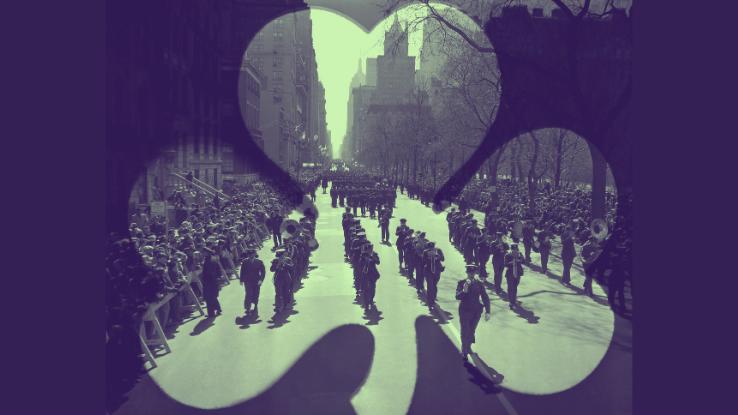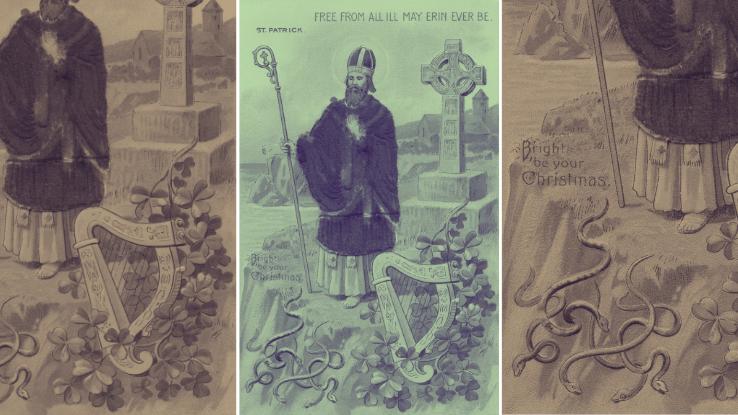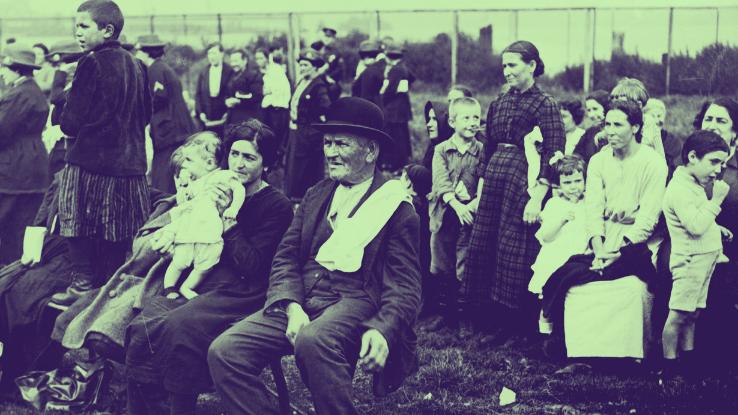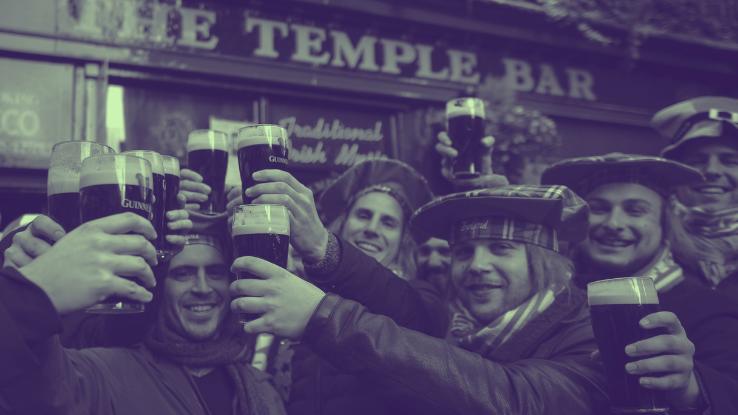Happy St Patricks Day Pot of Gold Free Clip Art

Whether you clothing light-green and crack open a Guinness or not, there's no fugitive St. Patrick's Day revelry. Celebrated annually on March 17, the vacation commemorates the titular saint's expiry, which occurred over one,000 years ago during the fifth century. Only our modern-twenty-four hours celebrations often seem like a far cry from the day's origins. From dying rivers green to pinching one another for not donning the day's traditional hue, these St. Patrick'southward Twenty-four hours customs, and the day's general development, have no doubt helped it endure. But, to celebrate, we're taking a await back at the holiday'south fascinating origins.
Who Was Saint Patrick?
Known as the patron saint of Republic of ireland, Patrick was born in Roman Britain. At the historic period of 16, he was kidnapped, enslaved, and brought to the Emerald Isle. While he did escape, Saint Patrick is credited with returning to Republic of ireland and bringing Christianity with him around 432 Advertisement, which is likely why he'due south been fabricated the state'southward national campaigner. Roughly 30 years later, Patrick died on March 17, but, from monasteries and churches to Christian schools, he clearly left an enduring legacy behind.

As happens after one's expiry, a number of legends cropped up around the saint. The most famous? Supposedly, he collection the snakes out of Republic of ireland, chasing them into the sea after they attacked him during a twoscore-day fast. Did the Christian missionary really accomplish this feat? It's unlikely, according to Nigel Monaghan, keeper of natural history at the National Museum of Ireland in Dublin. "At no time has there ever been any suggestion of snakes in Republic of ireland," Monaghan told National Geographic. "[There was] nothing for St. Patrick to banish." Another (much more plausible) story notes that Saint Patrick used a shamrock to illustrate the Holy Trinity — hence the three-leafed clover'south connectedness to the holiday.
To celebrate Saint Patrick's life, Ireland began commemorating him effectually the 9th or 10th century with religious services and feasts. Since March 17 falls during the Lent — a Christian season that prohibits the consumption of meat, amidst other things — revelers would nourish church building services in the morning time and celebrate the saint in the afternoon. All-time of all, they received special dispensation to eat Irish bacon, drink, and be merry.
Contrary to popular belief, the showtime St. Patrick's Day parade was thrown in North America in 1601. And, no, it wasn't held in Boston. In fact, the Irish vicar of what was then a Spanish colony — and what is now present-day St. Augustine, Florida — helmed the celebration. In 1737, Irish folks in Boston held what some considered to be the city's first St. Patrick'south Mean solar day parade — though information technology was more of a walk up Tremont Street, really. And, in 1762, Irish soldiers stationed in New York Urban center held their ain march to find St. Patrick's Day. Now, parades are an integral office of the revelry, specially in the United States where millions of people flock to the over 100 parades held annually throughout the land.
How Is St. Patrick's Twenty-four hour period Celebrated Today?
When the Peachy Spud Famine hit in the mid-1800s, nearly 1 one thousand thousand Irish people emigrated to the U.S. Many of these Irish immigrants faced discrimination based on the religion they practiced — largely Roman Catholicism — and their unfamiliar accents. While organizations, such as the New York Irish Aid society, tried to foster a sense of community and Irish patriotism on St. Patrick's Solar day, revelers were portrayed poorly in the media, furthering the bigotry the displaced Irish gaelic customs faced.

Just this all changed when Irish Americans recognized their own political power. St. Patrick'southward Day parades, and other events that celebrated Irish heritage, became pop — and even drew the attention of political hopefuls looking to capture the Irish American vote. Nowadays, the pride has continued to groovy, and then much and then that both people of Irish gaelic descent and those without whatsoever Irish heritage partake in the festivities. In the U.S., massive celebrations are held in major cities like Chicago, Boston, New York Urban center, and Savannah.
Outside of the States, Canada, Australia, and, of class, Republic of ireland go all out, too. In fact, up until the 1970s, the 24-hour interval was a traditional religious holiday in Ireland. Irish gaelic laws had mandated pubs to shut on March 17. But, in the 1990s, Ireland decided to use the holiday to drive tourism. Each year, the vacation attracts well-nigh ane million people to the country — and, in detail, to Dublin, which is home to Guinness, Ireland's famous stout.
Why Light-green? And Why Corned Beef?
And then, why is green associated with the holiday? It seems similar the obvious linkage is Ireland's apt nickname, the Emerald Isle, which references the country's lush greenery. But there's more to it than that. For one, at that place's the shamrock — a symbol of St. Patrick — and green is one of the colors that'due south been consistently used in Republic of ireland's flags. Notably, greenish too represented the Irish Catholics who rebelled against Protestant England. Perhaps surprisingly, blue was the original color associated with the holiday upwardly until the 17th century or then.

And, as you lot may know from St. Patrick'south Days past, there'due south also a long-standing tradition of being pinched for not wearing greenish. This potentially tedious trend started in the U.S. "Some say [the color green] makes you invisible to leprechauns who will pinch y'all if they tin come across you lot," ABC News 10 reports. Our advice? Make certain you're wearing something green on the day — or practice your dodging maneuvers until y'all're a regular Spider-Human being.
"Many St. Patrick'due south 24-hour interval traditions originated in the U.Southward.," Mental Floss points out. "Similar the compulsion to dye everything from our booze to our rivers green." And the traditional meal of corned beefiness and cabbage is no exception. In fact, corning is a manner to preserve beef, and, while it dates back to the Middle Ages, the exercise became pop amid Irish immigrants living in New York City in the 1800s.
"Looking for an culling [to table salt pork, or Irish gaelic salary], many Irish immigrants turned to the Jewish butchers in their neighborhoods," Mental Floss reports. "There, they found kosher corned beefiness, which was non only cheaper than table salt pork at the time, but had the aforementioned salty savoriness that made it the perfect commutation." Served up with cabbage, potatoes, carrots, and traditional Irish soda bread, this repast is a must-have every March. Oft, revelers will pair their corned beef dinner with a Guinness stout. In fact, it was estimated that 13 million pints of Guinness were consumed worldwide on March 17, 2017. And, in the U.South. alone, folks spent over $6 billion jubilant St. Patrick's Day in 2020.
Source: https://www.reference.com/history/holidays-101-celebrate-st-patrick-s-day-fc3bececede55417?utm_content=params%3Ao%3D740005%26ad%3DdirN%26qo%3DserpIndex